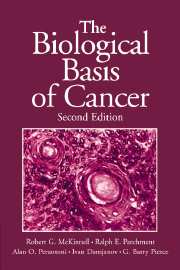Book contents
- Frontmatter
- Contents
- Preface
- Introduction: Letters illustrating clinical aspects of cancer
- 1 The pathology of cancer
- 2 Invasion and metastasis
- 3 Carcinogenesis
- 4 Genetics and heredity
- 5 Cancer-associated genes
- 6 Cancer in nonhuman organisms
- 7 Epidemiology
- 8 Lifestyle: Is there anything more important?
- 9 The stem cell basis of cancer treatment: concepts and clinical outcomes
- 10 Oncology: The difficult task of eradicating caricatures of normal tissue renewal in the human patient
- Appendix: Description of selected tumors
- Glossary
- References
- Index
- Plate section
4 - Genetics and heredity
Published online by Cambridge University Press: 05 June 2012
- Frontmatter
- Contents
- Preface
- Introduction: Letters illustrating clinical aspects of cancer
- 1 The pathology of cancer
- 2 Invasion and metastasis
- 3 Carcinogenesis
- 4 Genetics and heredity
- 5 Cancer-associated genes
- 6 Cancer in nonhuman organisms
- 7 Epidemiology
- 8 Lifestyle: Is there anything more important?
- 9 The stem cell basis of cancer treatment: concepts and clinical outcomes
- 10 Oncology: The difficult task of eradicating caricatures of normal tissue renewal in the human patient
- Appendix: Description of selected tumors
- Glossary
- References
- Index
- Plate section
Summary
[A]ll cancers exist in both hereditary and nonhereditary forms … the heritable cancers are all uncommon.
A. G. Knudson 1985For decades there has been no doubt that cancer is genetic, in the sense that transformation of a normal cell to invasive and malignant growth is due to changes in the DNA. But most cancer is genetic only at the level of the transformed cell, not in the germline of the patients.
M-C. King, S. Rowell, and S. M. Love 1993Introduction
The heredity of cancer deals with familial aspects of neoplasia. “Familial aspects of neoplasia”means simply that more members of a family suffer from cancer than would be expected. Human pedigrees are examined to detect if a cancer is indeed familial, that is, is the cancer found in greater abundance than expected and thus perhaps inherited from previous generations? Understanding the heredity of cancer requires an investigation not only of the pedigree of families, that is, genealogy, but also of chromosomes, genes, and gene products. In this sense, this chapter concerns both the genetics and heredity of cancer. The term “genomics”refers to the structure and function of the entire genome of a species, including the complete DNA sequence, the regulation of its expression and how its genes and gene products function in a species. A related field is “oncogenomics”and that term pertains to the genomics of cancer. Oncogenomics is a rapidly evolving discipline resulting from new technology.
- Type
- Chapter
- Information
- The Biological Basis of Cancer , pp. 126 - 144Publisher: Cambridge University PressPrint publication year: 2006
- 2
- Cited by

